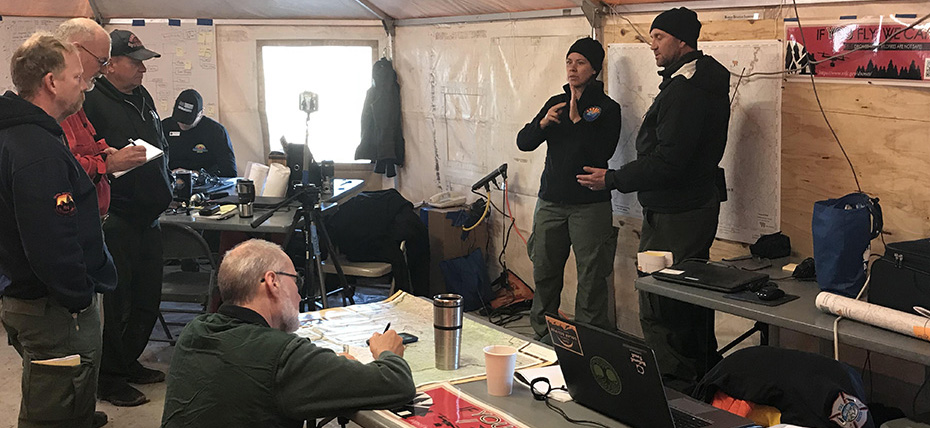Arizona’s ERIC Program Works to Improve Access to Emergency Information
Posted on by
Post updated: Aug. 31, 2021
Vicki Bond is not surprised at how hot, but by how cold the temperatures can get out on a wildfire. “I’ve worked on responses to more wildfires in freezing temperatures than in extreme heat,” she says.
Coincidentally, making sure people aren’t left out in the cold in an emergency is why she has so much experience with the weather.
Bond works for the Arizona Department of Emergency and Military Affairs (DEMA) as a licensed American Sign Language (ASL) interpreter and deployment coordinator for the Emergency Response Interpreters Credentialing (ERIC) program. She helps prepare licensed ASL interpreters and Communication Access Realtime Translation (CART) captioners to deploy for emergencies throughout the state.
ERIC interpreters and captioners work alongside emergency communicators to interpret and transcribe information presented at community meetings, media briefings, on websites and social media, and in evacuation shelters for people who are Deaf and hard of hearing.
“The goal of the ERIC program,” said Bond, “is to ensure Deaf and hard of hearing community members have access to critical information during emergencies and disasters in the State of Arizona.”
People in Arizona are at risk from a variety of hazards, including extreme heat, floods, and wildfire. More than 1,500 wildfires occur in Arizona each year.
Trial by Fire
The pilot year of the ERIC program was a literal trial by fire. In 2017, ERIC interpreters and CART providers deployed in response to one flood and nine wildfires, where long hours, limited supplies, and sleeping in tents are the rule.
Since then, ERIC staff of five captioners, 13 interpreters, and two certified Deaf interpreters have been deployed more than 500 times.
They have served emergency response for wildfires, flooding, COVID-19, exercises, public meetings, and news conferences. During the years 2020 and 2021, ERIC staff responded to 38 wildfires.
After supporting Arizona county and tribal partners for Point of Distribution (or POD) drills in 2019, CART staff were more than ready for the real thing and have played an invaluable role in COVID-19 response. CART captioners and interpreters have supported POD operations, news conferences, and virtual town meetings. They’ve worked on 125 COVID events since early 2020.
Bond hopes the sustained success of the ERIC program will help highlight the need for ASL translators and CART captioners on all emergencies. Bond and DEMA staff work to incorporate lessons learned and best practices into the program to ensure CART staff are well-equipped to respond to any incident. For example, CART staff now complete tribal cultural awareness training as part of their annual refresher.
Know Your Community
It is not a matter of if you will need an interpreter and captioner, but when you will need them. In Arizona, an estimated 1.1 million people are hard of hearing, and over 20,000 people are culturally Deaf and use ASL as their primary language.
Public health and emergency management agencies can use tools like Community Assessment for Public Health Emergency Response (CASPER) surveys to assess local health and communication needs, and collect data that can help emergency planners know when to request resources like interpreters and captioners. The earlier the better in most cases.
Think Accessibility
In today’s “digital first” world, where half of visitors to CDC.gov come on mobile devices first, it is important to think about accessibility throughout the process of creating content, from conceptualization to publication.
Small print, videos without captions, and the use of long and technical language in printed materials and on websites are barriers to communication and possible violations of federal and state laws. Section 508 of the Rehabilitation Act and other laws like it help protect people who have disabilities that affect their ability to hear, speak, read, write, and understand information.
Here are 5 ways to create web and social media content that is useful, usable, and accessible:
- Add alternate text (or AltText) to images.
- Caption social media video and web video.
- Provide transcripts for videos and podcasts, and interpreters for livestreams.
- Improve the readability of print materials with large text.
- Write in plain language to increase understanding of your message.
Related resources:
- Common Barriers to Inclusion
- Hearing Loss in Children: Building Languages
- Crisis & Emergency Risk Communication (CERC)
- Usability.gov
- PlainLanguage.gov


Post a Comment